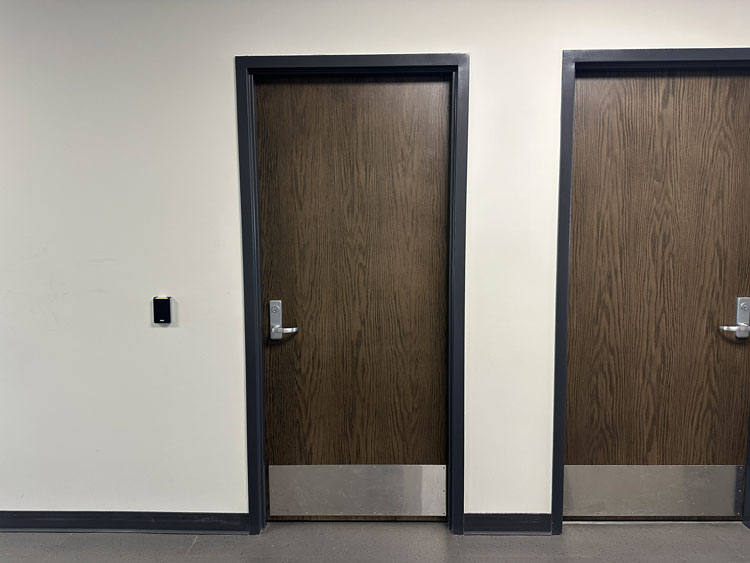Material choices can pay off over the long haul
 Not every value engineering idea saves money on the front-end of construction. These hollow metal doors, wood grain stamped and stained at the factory, will pay for the higher cost through significantly higher durability and lifespan. (CANCO)
Not every value engineering idea saves money on the front-end of construction. These hollow metal doors, wood grain stamped and stained at the factory, will pay for the higher cost through significantly higher durability and lifespan. (CANCO)
11 months ago
Building Value
Choices that save on long-term operational and maintenance costs are an important part of pre-construction value engineering.
Among the pre-construction services we provide to K-12 clients on construction management projects, value engineering and constructability review are key components in our track record of delivering value to clients. In some instances, these efforts lead to savings that are counted in the hundreds of thousands of dollars, and can add into the millions. In one such case, we helped bring a project back into budget during the design phase in part by recommending that hallways be narrowed and ceilings lowered ever-so-slightly to reduce material costs without having a material impact on usability or quality.
Other times, our value-building recommendations occur as part of material selection, and frequently have as much to do with life-cycle cost savings as they do upfront savings on construction.
Examples of these on recent or ongoing Carl A. Nelson & Company projects include:
Impact-resistant drywall: To reduce the institutional feel of their buildings, many K-12 clients are choosing to include drywall in hallways and classrooms. Our high school renovation project for the Burlington Community School District in southeast Iowa is an example of this. Metal stud and drywall construction is about half the cost of concrete mason unit (CMU) walls. However, sheetrock can be very prone to damage — especially in high-traffic areas. That is why we see clients making the choice to use impact-resistant drywall.
While about 10% more expensive than traditional drywall as a factor in front-end construction cost, high-impact drywall can produce significant savings in the long-run by reducing expenses for repair and replacement over the life of the building.
Hollow-core metal doors: Similar to drywall, doors vary in their characteristics for initial cost and long-term durability. At Burlington High School, where we are working as construction manager, the initial design included stained and factory finished solid-core wood doors, but we recommended switching to factory wood grain stamped and stained hollow metal doors to obtain the improved life-cycle cost benefits for the long-term.
While the metal option cost about $100 more per door, the ongoing maintenance cost will be low and the life expectancy extended.
Door lock systems: Peace-of-mind can be hard to put a price tag on, unless it is for door locks that permit any staff member to lock any room from the inside during a building lockdown.
Compared to thumb turn-activated classroom locksets, inside keyed locks allow the advantage of not enabling students to lock a teacher out of the room. The disadvantage to safety is that in a key-turned lockset, lacking the correct key makes it impossible to lock the door. Burlington High School opted for classroom security locks that are keyed, but can be locked by any teacher’s key, not just the key corresponding to the lock. This keying strategy didn’t add any cost to the project.
Another area with increasing application of special-function locks are private staff and special needs toilets, which are accessed from the outside with a key and locked from the inside with a thumb turn. By specifying these locks as hotel functions with visual indication, the users can determine from the outside if the toilets are occupied. With the hotel function, a standard key will not open the door when the thumb turn is locked on the inside, avoiding intrusion when occupied. In the case of an emergency, administration can use an emergency override key to open the door even if locked on the inside.
The cost of this function is minor.
Exterior windows: On a recent project for the Shenandoah Community School District in southwest Iowa, where we were construction manager on a window replacement project at the district’s K-8 building, Carl A. Nelson & Company recommended a lower-cost, more functional option to the original design.
Our team determined the specified curtain wall system would greatly exceed the available budget for the project, and recommended a change to an aluminum window with jamb extensions for the replacement windows. In addition to providing significant savings that allowed the project to meet budget, the district was able to use the savings to add the integral blinds it previously could not afford.
•••
In Building Value, Carl A. Nelson & Company’s team of construction experts will address topics aimed at helping educational facility owners to get the most out of their projects before, during and after construction. Have questions? Submit it by email to canco@carlanelsonco.com for a prompt reply and possible use as a topic in an upcoming installment.